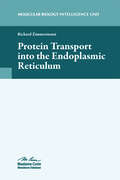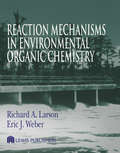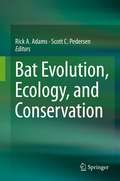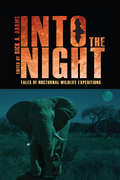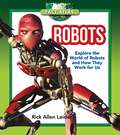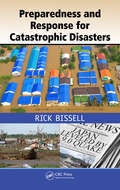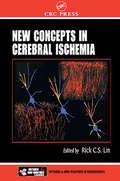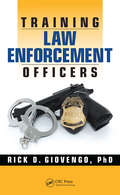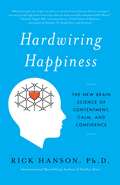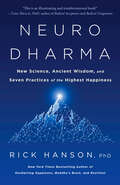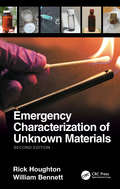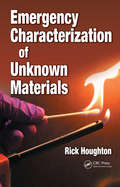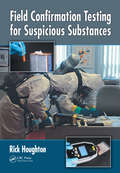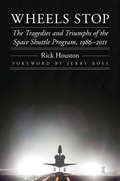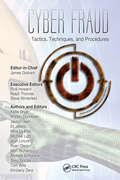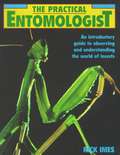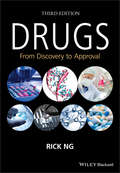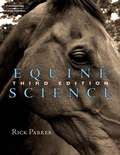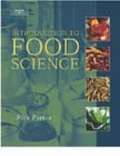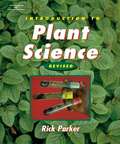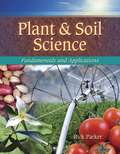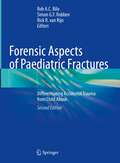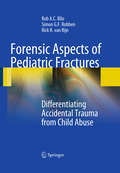- Table View
- List View
Protein Transport into the Endoplasmic Reticulum
by Richard ZimmermannProtein transport into the endoplasmic reticulum (ER) is just one aspect of the general cell biology topic of intracellular protein sorting. This larger picture also includes protein transport into other organelles of the eukaryotic cell (chloroplasts, mitochondria, nucleus, peroxisomes), protein export from bacteria, vesicular transport that deliv
Reaction Mechanisms in Environmental Organic Chemistry
by RichardA. LarsonReaction Mechanisms in Environmental Organic Chemistry classifies and organizes the reactions of environmentally important organic compounds using concepts and data drawn from traditional mechanistic and physical organic chemistry. It will help readers understand these reactions and their importance for the environmental fates or organic compounds of many types. The book has a molecular and mechanistic emphasis, and it is organized by reaction type. Organic molecules and their fates are examined in an ecosystem context. Their reactions are discussed in terms that organic chemists would use. The book will benefit organic chemists, environmental engineers, water treatment professionals, hazardous waste specialists, and biologists. Although conceived as a comprehensive monograph, the book could also be used as a text or reference for environmental chemistry classes at the undergraduate or graduate level.
Bat Evolution, Ecology, and Conservation
by Rick A. Adams Scott C. PedersenRecent advances in the study of bats have changed the way we understand this illusive group of mammals. This volume consist of 25 chapters and 57 authors from around the globe all writing on the most recent finding on the evolution, ecology and conservation of bats. The chapters in this book are not intended to be exhaustive literature reviews, but instead extended manuscripts that bring new and fresh perspectives. Many chapters consist of previously unpublished data and are repetitive of new insights and understanding in bat evolution, ecology and conservation. All chapters were peer-reviewed and revised by the authors. Many of the chapters are multi-authored to provide comprehensive and authoritative coverage of the topics.
Counseling And Educational Research: Evaluation And Application, 3rd Edition
by Rick A. HouserThe Third Edition of Counseling and Educational Research: Evaluation and Application emphasizes the importance of being a good consumer of research and teaches readers how to conduct research in practice. Written in an engaging, conversational tone, the book uses concrete examples from professional literature to demonstrate how to effectively evaluate and interpret research articles--without relying on discipline-specific jargon. The Third Edition features new examples, updated research, a new chapter on single-subject research, a new chapter on the use of technology and research, and much more.
Into the Night: Tales of Nocturnal Wildlife Expeditions
by Rick AdamsThis entertaining collection of essays from professional scientists and naturalists provides an enlightening look at the lives of field biologists with a passion for the hidden world of nocturnal wildlife. Into the Night explores the harrowing, fascinating, amusing, and largely unheard personal experiences of scientists willing to forsake the safety of daylight to document the natural history of these uniquely adapted animals. Contributors tell of confronting North American bears, cougars, and rattlesnakes; suffering red ctenid spider bites in the tropical rain forest; swimming through layers of feeding-frenzied hammerhead sharks in the Galapagos; evading the wrath of African bull elephants in South Africa; and delighting in the curious and gentle nature of foxes and unconditional acceptance by a family of owls. They describe “fire in the sky” across a treeless tundra, a sea ablaze with bioluminescent algae, nighttime earthquakes on the Pacific Rim, and hurricanes and erupting volcanoes on a Caribbean island. Into the Night reveals rare and unexpected insights into nocturnal field research, illuminating experiences, discoveries, and challenges faced by intrepid biologists studying nature’s nightly marvels across the globe. This volume will be of interest to scientists and general readers alike.
Robots: Explore the World of Robots and How They Work for Us (Fact Atlas Series)
by Rick Allen LeiderRobots exist for so many different reasons. Many robots replace humans, whether it’s because a situation is dangerous or just tedious. There are rover robots to explore space and drone robots that play a part in our military today, but then there are also vacuum robots available for the average household’s chores. In Japan, there is a robot teacher that can mimic a wide range of human emotions--including anger at uncooperative students--thanks to eighteen small motors hidden beneath the latex skin covering her face. The Japanese government hopes to use robots to fill jobs left vacant by an anticipated labor shortage due to an aging population. In the United States, robots even help with surgery, allowing for incisions to be cut much smaller than they would be otherwise--meaning fewer complications and faster recovery times. This fascinating book in the Fact Atlas series explores the history of robots, from the very first robot designed by Leonardo da Vinci to predictions of the roles robots will play in our future. Kids will learn about how robots are often modeled after real life-forms, such as bees, sharks, and, of course, humans. Robots also takes into account the robots in pop culture--robots we have imagined could be a part of our future. Readers can decide for themselves whether or not they think robots should be developed to their fullest potential or kept in check by safety limitations.
Preparedness and Response for Catastrophic Disasters
by Rick BissellBased on a popular course for the FEMA Higher Education project, Preparedness and Response for Catastrophic Disasters provides important insight into plans to mitigate and respond to the devastation caused by large-scale catastrophic events. Hurricane Katrina provided clear evidence that these occurrences are both qualitatively and quantitatively d
New Concepts in Cerebral Ischemia (Frontiers in Neuroscience)
by Rick C.S. LinApproximately half a million Americans suffer brain ischemic episodes every year. These brain strokes are the third leading cause of death in the United States and the number-one cause of permanent disability. Over the past decade, we have made extensive attempts to understand the biological mechanisms that underlie stroke-induced neuronal injury. Providing a detailed description of the techniques and theories employed in both basic and clinical research, New Concepts in Cerebral Ischemia delineates the mechanisms underlying neuronal damage induced by ischemia. The book covers methods to elucidate the pathogenesis of ischemia, technologies used in the design of specific strategies to protect neurons from further injury, and new approaches to treat patients with acute ischemic episodes. It includes methods and therapeutic approaches for neuronal protection against acute and chronic ischemic episodes and describes new animal models for ischemia research including the application of transgenic animals.
Training Law Enforcement Officers
by Rick D. GiovengoThis how-to guide covers every aspect of law enforcement training, from training academy administration, to designing curricula, to identifying and utilizing qualified instructors. Using the latest methodologies, technologies, and best practices, Training Law Enforcement Officers gives law enforcement administrators, training specialists, instructors, instructional systems designers, and academy directors a proven way to conduct training for all levels of practitioners, from basic law enforcement to high-risk law enforcement. At a time when scrutiny of law enforcement officers is on the rise, Training Law Enforcement Officers is an essential guide for those criminal justice practitioners seeking to minimize police error and make today’s police force the best that it can be.
Reviewing: Biology
by Rick HallmanThis review book provides a complete review of a one-year biology course that meets the NYS Living Environment Core Curriculum. Includes four recent Regents exams.
Hardwiring Happiness: The New Brain Science of Contentment, Calm, and Confidence
by Rick HansonWhy is it easier to ruminate over hurt feelings than it is to bask in the warmth of being appreciated? Because your brain evolved to learn quickly from bad experiences but slowly from the good ones. You can change this. Hardwiring Happiness lays out a simple method that uses the hidden power of everyday experiences to build new neural structures full of happiness, love, confidence, and peace. Dr. Hanson's four steps build strengths into your brain-- balancing its ancient negativity bias--making contentment and a powerful sense of resilience the new normal. In mere minutes each day, we can transform our brains into refuges and power centers of calm and happiness.From the Hardcover edition.
Neurodharma: New Science, Ancient Wisdom, and Seven Practices of the Highest Happiness
by Rick Hanson PhDLOS ANGELES TIMES BESTSELLER • &“An easy-to-follow road map for creating day-to-day inner peace in today&’s increasingly complex world.&”—Lori Gottlieb, MFT, New York Times bestselling author of Maybe You Should Talk to SomeoneThroughout history, people have sought the heights of human potential—to become as wise and strong, happy and loving, as any person can ever be. And now recent science is revealing how these remarkable ways of being are based on equally remarkable changes in our own nervous system, making them more attainable than ever before. In Neurodharma, the follow-up to his classic Buddha&’s Brain, New York Times bestselling author Rick Hanson, PhD, not only explores the new neuroscience of awakening but also offers a bold yet plausible plan for reverse-engineering peak experiences, sense of oneness, and even enlightenment itself. And he does so with his trademark blend of solid science and warm encouragement, guiding you along this high-reaching path with good humor, accessible tools, and personal examples. A groundbreaking yet practical book, Neurodharma shares seven practices for strengthening the neural circuitry of profound contentment and inner peace—qualities that offer essential support in everyday life while also supporting the exploration of the most radical reaches of human consciousness. Step by step, this book explains how to apply these insights in order to cultivate unshakable presence of mind, a courageous heart, and serenity in a changing world. The breakthroughs of the great teachers are not reserved for the chosen few. Dr. Hanson shows how we can embody them ourselves in daily life to handle stress, heal old pain, feel at ease with others, and rest in the sense of our natural goodness. The Buddha didn&’t use an MRI to become enlightened. Still, 2,500 years after he walked the dusty roads of northern India, neuroscientists are discovering the mechanisms of the brain that underpin the Buddha&’s penetrating analysis of the mind. With deep research, stories, guided meditations, examples, and applications, Dr. Hanson offers a fascinating, inspiring vision of who we can be—and an effective path for fulfilling this wonderful possibility.
Emergency Characterization of Unknown Materials
by William Bennett Rick HoughtonEmergency Characterization of Unknown Materials, Second Edition is fully updated to serve as a portable reference that can be used in the field and laboratory by workers who are responsible for a safe response to and management of unknown hazardous materials. As with the first edition, the book emphasizes public safety and the management of life safety hazards, including strategies and emerging technologies to identify the hazards presented by an unknown material. When responding to a hazardous material emergency involving an unknown substance, firefighters and HAZMAT teams are primarily interested in protecting public safety. The book details risk analysis procedures to identify threats and vulnerabilities, analyzing them to determine how such risks can be eliminated or reduced. If an unknown material can be identified with a high degree of confidence, that can considerably change the response, and measures to be taken. In addition, the book covers practical field applications with updated and additional examples of field instruments. The hazard identification methods presented are intended for use by frontline workers. The test methods presented involve manipulation of small sample amounts – using, literally, a hands-on approach. The three technologies used by first responders and military personnel to identify unknown chemicals, Raman spectroscopy, FTIR spectroscopy and high-pressure mass spectroscopy, are covered in depth. Features Presents how to identify unknown materials and, if identification is not possible, to characterize the hazards of the material Offers practical examples to introduce new first responders to hazardous materials response Provides up-to-date field applications of the latest developments in commercially available instrumentation Details practical sample manipulations to help the reader successfully identify materials with popular high-end instrumentation Includes several examples of spectra and describes ways in which the reader can utilize data to inform decision making New coverage to this edition includes a chapter and content that focuses on sample manipulation and separations using instruments developed and revised since the first edition was published. These sample manipulations may be performed in the field with a very simple toolkit, which is fully outlined and explained in detail. Identifying the hazards of the unknown substance is essential to plan for response, contingencies and sustained actions. As such, Emergency Characterization of Unknown Materials, Second Edition will be a welcome and essential resource to all response and safety professionals concerned with hazardous materials.
Emergency Characterization of Unknown Materials
by Rick HoughtonDeliberately, accidentally, or consequentially, first responders and waste site workers handle unknown substances of varying degrees of danger every day. Unidentified chemicals involved with clandestine production of WMD agents or drugs, explosive materials, unlabeled waste, and forensic samples all pose a threat to the worker and those they prote
Field Confirmation Testing for Suspicious Substances
by Rick HoughtonFrequently a substance found at a port of entry, waste site, laboratory triage facility, or even in a hazardous materials emergency will be labeled and purportedly identified. But law enforcement and other first responders cannot take this claim at face value, as the accuracy is not confirmed and must be verified. A comprehensive handbook for on-th
Wheels Stop: The Tragedies and Triumphs of the Space Shuttle Program, 1986-2011 (Outward Odyssey: A People's History of Spaceflight)
by Rick HoustonHumanity&’s first reusable spacecraft and the most complex machine ever built, NASA&’s Space Shuttle debuted with great promise and as a dependable source of wonder and national pride. But with the Challenger catastrophe in 1986, the whole Space Shuttle program came into question, as did NASA itself, so long an institution that was seemingly above reproach. Wheels Stop tells the stirring story of how, after the Challenger disaster, the Space Shuttle not only recovered but went on to perform its greatest missions. From the Return to Flight mission of STS-26 in 1988 to the last shuttle mission ever on STS-135 in 2011, Wheels Stop takes readers behind the scenes as the shuttle&’s crews begin to mend Cold War tensions with the former Soviet Union, conduct vital research, deploy satellites, repair the Hubble Space Telescope, and assist in constructing the International Space Station. It also tells the heart-wrenching story of the Columbia tragedy and the loss of the magnificent STS-107 crew.As complex as the shuttle was, the people it carried into orbit were often more so—and this is their story, too. Close encounters with astronauts, flight controllers, and shuttle workers capture the human side of the Space Shuttle&’s amazing journey—and invite readers along for the ride. Browse more spaceflight books at upinspace.org.Purchase the audio edition.
Cyber Fraud: Tactics, Techniques and Procedures
by Rick HowardWith millions lost each year, cyber crime has evolved from a minor nuisance to a major concern involving well-organized actors and highly sophisticated organizations. Arguably one of the most important challenges of the 21st century, with millions lost each year, cyber crime has evolved from a minor nuisance to a major concern involving well-organized actors and highly sophisticated organizations. This volume explores the state of threats present in the cyber fraud underground. It discusses phishing/pharming, trojans/toolkits, direct threats, and pump-and-dump scams. By examining the operations of the cyber criminal, the book provides perspective into the general incentives, risks, and behavioral patterns of the fraudsters. Armed with this information, organizations and individuals are better able to develop countermeasures and crafting tactics to disrupt the fraud underground and secure their systems.
The Practical Entomologist
by Rick Imes<p>From exploring the basic principles of entomology to starting a collection, The Practical Entomologist is the perfect introduction to the world of insects. <p>Beginning with the basics, the text describes what characterizes an insect, including anatomy and the life cycle. It takes an order-by-order look at insects, explaining how each group differs from another and why certain types of insects have been classified together. The book shows you not only what to look for but how and where to look for it -- from capturing and keeping live insects to ways of making a collection and taking photographs. <p>Tips on keeping a field notebook are also included. Packed with more than 200 full-color illustrations, this comprehensive guide is a valuable reference tool for nature enthusiasts.</p>
Drugs
by Rick Ng"Concise and easy to read, the book quickly introduces basic concepts, then moves on to discuss target selection and the drug discovery process for both small and large molecular drugs."--Doody's Reviews, May 2009"The second edition of a book that offers a user-friendly step-by-step introduction to all the key processes involved in bringing a drug to the market, including the performance of preclinical trials."--Chemistry World, February 2009The new edition of this best-selling book continues to offer a user-friendly, step-by-step introduction to all the key processes involved in bringing a drug to the market, including the performance of pre-clinical studies, the conduct of human clinical trials, regulatory controls, and even the manufacturing processes for pharmaceutical products. Concise and easy to read, the book quickly introduces basic concepts, then moves on to discuss target selection and the drug discovery process for both small and large molecular drugs.This second edition features many key enhancements, including Key Points, Chapter Summary, and Review Questions in each chapter, Answers to Review Questions provided in a book-end appendix, and one or two carefully selected "mini" case studies in each chapter.Richly illustrated throughout with over ninety figures and tables, this important book also includes helpful listings of current FDA and European guidelines and a special section on regulatory authority and processes in China. It is an indispensable resource for pharmaceutical industry and academic researchers, pharmaceutical managers and executives, healthcare clinicians, policymakers, regulators, and lobbyists with an interest in drug development. It is also an excellent textbook for students in pharmacy, science, and medicine courses.
Equine Science (3rd edition)
by Rick ParkerHorses hold a special place in North America's history and culture. As America evolved, horses contributed to the economy by providing power for transportation and industry. Today horses still contribute to the economy but in a much different way. According to a study commissioned by the American Horse Council Foundation, the 9.2 million horses in the United States contribute $39 billion annually in direct economic impact and support 1.4 million jobs on a full-time basis. When indirect spending is included, the horse industry's economic impact reaches $102 billion annually. The overall economic impact of horses comes from racing, recreation, sports, rodeos, farm work, pleasure riding, and competitions. While millions of people participate in the horse industry as spectators, almost 5 million Americans are involved in the industry as horse owners, service providers, employees, and volunteers. Horses are found in every state, and 45 states have at least 20,000 horses. The horse industry is vital and growing. With this vitality and growth comes the need for information about horses, so the numbers of horse-related educational programs, books, pamphlets, videos, and Internet sites are increasing rapidly.
Introduction to Food Science
by Rick Parker"Introduction to Food Science" provides an overview of the science of foods, from nutrition and digestion to processing and preservation. The material is based on a thorough, easy-to-follow outline that makes developing a lesson plan simple. Each chapter contains a list of learning objectives that help identify important concepts and key words that are essential to the understanding of the material. Tables, charts, graphs and illustrations are inserted throughout the text, providing quick and understandable access to information. The "student activities" section at the end of each chapter provide opportunities to directly apply material. The text also provides insight into career opportunities for those interested in working within food science industries.
Introduction to Plant Science (Revised edition)
by Rick ParkerThis revised text provides a comprehensive introduction to the fascinating world of plant science. From the basic requirements for plant growth, to genetic engineering and biotechnology, this easy- to- understand book is ideal for the high school level agriscience curriculum or college freshman level plant science course. Students will learn about the origins of cultivated plants, structure and anatomy, photosynthesis, respiration, propagation, production of major agronomic crops, and more.
Plant and Soil Science: Fundamentals and Applications
by Rick ParkerThis book combines the basic knowledge of plant and soil science, in an easy to read and teach format, and provides practical real world application for information learned. Organized into twenty-eight chapters, each chapter features learning objectives, key terms, tables, charts, illustrations and color photographs to aid the learning and teaching process.
Forensic Aspects of Paediatric Fractures: Differentiating Accidental Trauma from Child Abuse
by Rick R. van Rijn Rob A. C. Bilo Simon G. F. RobbenThis excellently illustrated book, now in a revised and extended second edition, not only describes the radiological findings which can be found in child abuse cases but also places them in a forensic perspective – a crucial aspect often underrepresented in radiological books. The aim is to enable physicians involved in non-accidental trauma cases to interpret radiological findings in light of the forensic circumstances under which these findings have arisen. Accordingly, the book will assist in determining whether a fracture is accidental or the result of abuse. Fractures are addressed not only by anatomical location but also by trauma mechanism, with careful attention to evidence regarding the reported mechanism and the clinical outcome. Drawing on the latest literature, the authors explain whether a particular form of trauma can cause a particular injury and identify where the reader can find the supporting evidence. The book will be essential reading and a superb reference for all who are involved in the diagnosis of child abuse, including pediatricians, emergency room physicians, and radiologists. It will also be a valuable resource for legal medicine physicians, lawyers, and judges.
Forensic Aspects of Pediatric Fractures
by Rick R. van Rijn Rob A. Bilo Simon G. RobbenFractures are a common finding in children and it is estimated that 2.1% of all children will suffer at least one fracture before the age of 16. With young children in particular, the question may arise if this is related to child abuse. The aim of this book is to help physicians involved in child abuse cases to interpret radiological findings in light of the forensic circumstances under which they occurred. The authors present up-to-date literature related to the mechanisms underlying non-accidental cases of trauma. In this book not only the radiological findings in child-abuse are discussed, but more importantly, these findings are analyzed from a forensic perspective. Careful attention is paid to evidence regarding reported trauma mechanisms and their clinical outcome; for example, can a fall from a couch result in a femoral fracture, and if not, where is the supporting evidence?
